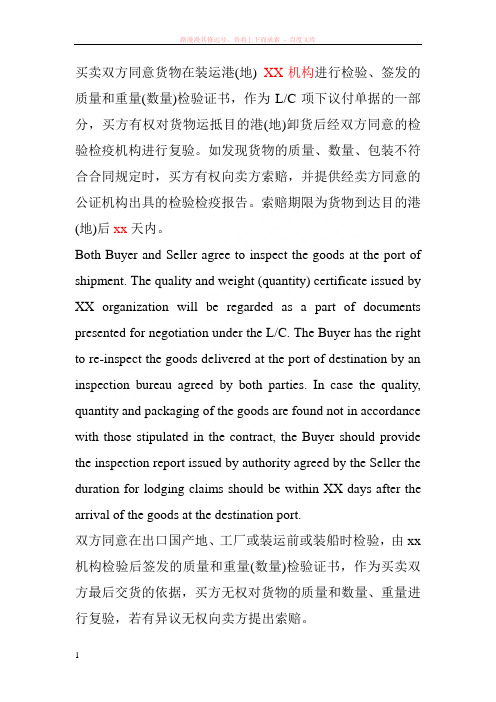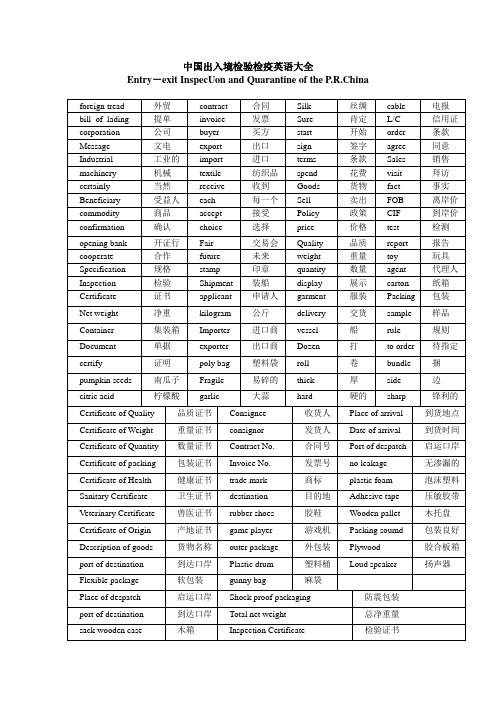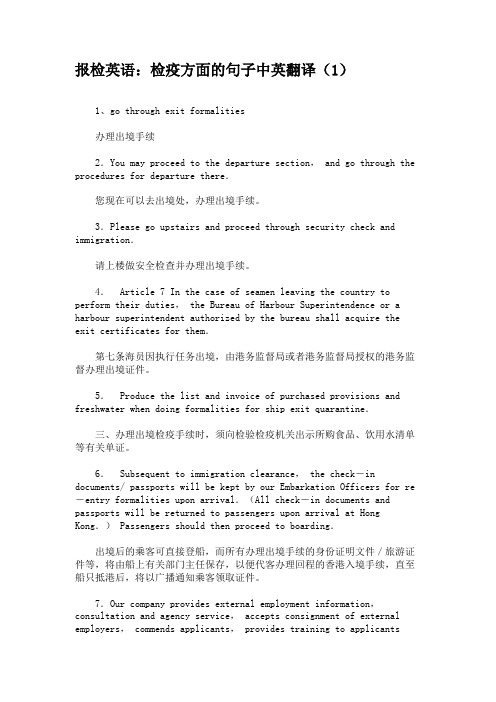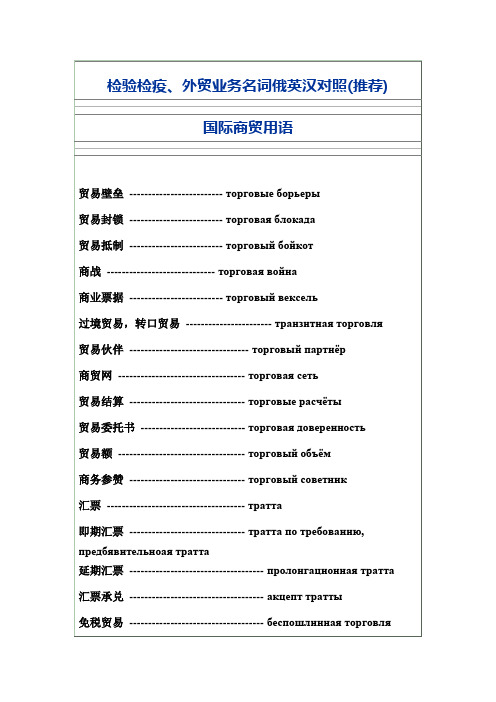报检英语:检疫方面的句子中英翻译(4).
- 格式:doc
- 大小:14.50 KB
- 文档页数:1

买卖双方同意货物在装运港(地)XX机构进行检验、签发的质量和重量(数量)检验证书,作为L/C项下议付单据的一部分,买方有权对货物运抵目的港(地)卸货后经双方同意的检验检疫机构进行复验。
如发现货物的质量、数量、包装不符合合同规定时,买方有权向卖方索赔,并提供经卖方同意的公证机构出具的检验检疫报告。
索赔期限为货物到达目的港(地)后xx天内。
Both Buyer and Seller agree to inspect the goods at the port of shipment. The quality and weight (quantity) certificate issued by XX organization will be regarded as a part of documents presented for negotiation under the L/C. The Buyer has the right to re-inspect the goods delivered at the port of destination by an inspection bureau agreed by both parties. In case the quality, quantity and packaging of the goods are found not in accordance with those stipulated in the contract, the Buyer should provide the inspection report issued by authority agreed by the Seller the duration for lodging claims should be within XX days after the arrival of the goods at the destination port.双方同意在出口国产地、工厂或装运前或装船时检验,由xx 机构检验后签发的质量和重量(数量)检验证书,作为买卖双方最后交货的依据,买方无权对货物的质量和数量、重量进行复验,若有异议无权向卖方提出索赔。


报检英语:检疫方面的句子中英翻译(1)1、go through exit formalities办理出境手续2.You may proceed to the departure section, and go through the procedures for departure there.您现在可以去出境处,办理出境手续。
3.Please go upstairs and proceed through security check and immigration.请上楼做安全检查并办理出境手续。
4.Article 7 In the case of seamen leaving the country to perform their duties, the Bureau of Harbour Superintendence or a harbour superintendent authorized by the bureau shall acquire the exit certificates for them.第七条海员因执行任务出境,由港务监督局或者港务监督局授权的港务监督办理出境证件。
5.Produce the list and invoice of purchased provisions and freshwater when doing formalities for ship exit quarantine.三、办理出境检疫手续时,须向检验检疫机关出示所购食品、饮用水清单等有关单证。
6.Subsequent to immigration clearance, the check-in documents/ passports will be kept by our Embarkation Officers for re -entry formalities upon arrival.(All check-in documents and passports will be returned to passengers upon arrival at Hong Kong.) Passengers should then proceed to boarding.出境后的乘客可直接登船,而所有办理出境手续的身份证明文件/旅游证件等,将由船上有关部门主任保存,以便代客办理回程的香港入境手续,直至船只抵港后,将以广播通知乘客领取证件。


中国出入境检验检疫1.foreign teade (外贸)contract(合同)invoice(发票)2.bill of lading(提单)L/C (信用证)buyer(买方)3.import(进口) export(出口) corporation(公司)4. Textile (纺织品) telephone(电话) manager(经理)5. Message (文电) order (条款) trouble (麻烦)6. Minute (分钟) agree (同意) machinery(机械)7. Sales(销售) receive(收到) cable(电报)8. Customer(顾客) accept(接受) choice(选择)9. Industrial(工业的) product(产品) terms(条款)10. Important(重要) sign(签字) each (每一个)11. Business(业务) start(开始) wait(等待)12. Sure(肯定) service(服务) rest(休息)13. Fair(交易会) spend(花费) certainly(当然)14. Goods(货物) display(展示) commodity(商品)15. Silk(丝绸) garment(服装) sample(样品)16. Sell(卖出) market(市场) world(世界)17. Example(例子) of course(当然) popular(流行的)18. Policy(政策) visit (拜访) relation(关系)19. Past(过去的) fact(事实) benefit(利益)20. Commercial(商业的) cooperate(合作) future(未来)21. Specification(规格) price(价格)22. FOB(离岸价) CIF(到岸价)23. Inspection(检验) test(检测) report(报告)24. Certificate(证书) stamp(印章) health(健康)25. Quality(品质) weight(重量) quantity(数量)26. Wrong(错误的) colour(颜色) date(曰期)27. Shipment(装船) answer(回答) delivery(交货)28. Size(尺码) percent (百分之) toy(玩具)29. Packing(包装) carton(纸箱) kilogram(公斤)30. Net weight(净重) confirmation(确认)agent(代理人)31. Beneficiary(受益人) applicant(申请人) opening bank(开证行)32. Certificate of Quality(品质证书) Certificate of Weight(重量证书)33. Certificate of Quantity(数量证书) Certificate of packing(包装证书)34. Certificate of Health(健康证书) Certificate of Quarantine(检疫证书)35. Veterinary Certificate(兽医证书) Sanitary Certificate(卫生证书)36. Certificate of Origin(产地证书) Certificate of Fumigation(熏蒸证书)37. Fumigation / Disinfection Certificate(熏蒸/消毒证书)38. Animal Health Certificate(动物卫生证书)39. Phytosanitary Certificate(植物检疫证书)40. Phytosanitary Certificate For Re - export(植物转口检疫证书)41. Sanitary Certificate For Conveyance(交通工具卫生证书)42. Quarantine Certificate For Conveyance(运输工具检疫证书)43. Veterinary Health Certificate(兽医卫生证书)44. Consignee(收货人) consignor(发货人)45. Description of goods(货物名称)46. Quantity / weight declared(报检数/重量)47. Contract No.(合同号) Invoice No.(发票号)48. Place of arrival(到货地点) means of Conveyance(运输工具)49. Date of arrival (到货时间) B/L or Way Bill No.(提单或运单号)50. Place of despatch(启运口岸) port of destination(到达口岸)51. Date of completion of discharge(卸货曰期)52. Mark & No.(标签及号码) destination(目的地)53. Name and No. of Conveyance(运输工具名称及号码)54. Port of despatch(启运口岸) port of destination(到达口岸)55. Date of arrival / departure(到达/离境曰期)56. Name and address of consignor(发货人名称及地址)57. Name and address of consignee(收货人名称及地址)58. Number and type of packages(包装种类及数量)59. Document(单据) rule(规则) bank(银行)60. Importer(进口商) exporter(出口商) trade mark(商标)61. Container(集装箱) vessel(船) to order(待指定)62. Plastic drum(塑料桶) gunny bag(麻袋)sack wooden case(木箱)63. Packing material(包装材料) outer package(外包装)64. Flexible package (软包装) transparent package(透明包装)65. Wooden pallet(木托盘) corrugated carton (瓦楞纸箱)66. Plywood(胶合板箱) poly bag(塑料袋)67. Vacuum packaging(真空包装) cushioning material(衬垫材料)68. Dozen(打) roll(卷) bundle(捆)69. Water proof packaging(防水包装) rustproof packaging(防锈包装)70. Moisture proof packaging(防潮包装)71. Shock proof packaging(防震包装)72. Adhesive tape(压敏胶带) plastic foam(泡沫塑料)73. Long(长) high(高) thick(厚)74. Top(顶) bottom(底) side(边)75. Fragile(易碎的) hard(硬的) sharp(锋利的)76. Packing soumd(包装良好) no leakage(无渗漏的)77. Total net weight(总净重量) pumpkin seeds(南瓜子) garlic(大蒜)78. Bike(自行车) rubber shoes(胶鞋) game player(游戏机)79. Loud speaker(扬声器) citric acid(柠檬酸)80. Inspection Certificate(检验证书) certify(证明)81. GuangDong Native Product Import & export Corporation(广东土产进出口公司)82. The goods were packed in gunny bags of 50kgs net each.(货物用麻袋包装,每袋净重50公斤.)62. Plastic drum(塑料桶) gunny bag(麻袋)sack wooden case(木箱)63. Packing material(包装材料) outer package(外包装)64. Flexible package (软包装) transparent package(透明包装)65. Wooden pallet(木托盘) corrugated carton (瓦楞纸箱)66. Plywood(胶合板箱) poly bag(塑料袋)67. Vacuum packaging(真空包装) cushioning material(衬垫材料)68. Dozen(打) roll(卷) bundle(捆)69. Water proof packaging(防水包装) rustproof packaging(防锈包装)70. Moisture proof packaging(防潮包装)71. Shock proof packaging(防震包装)72. Adhesive tape(压敏胶带) plastic foam(泡沫塑料)73. Long(长) high(高) thick(厚)74. Top(顶) bottom(底) side(边)75. Fragile(易碎的) hard(硬的) sharp(锋利的)76. Packing soumd(包装良好) no leakage(无渗漏的)77. Total net weight(总净重量) pumpkin seeds(南瓜子) garlic(大蒜)78. Bike(自行车) rubber shoes(胶鞋) game player(游戏机)79. Loud speaker(扬声器) citric acid(柠檬酸)80. Inspection Certificate(检验证书) certify(证明)81. GuangDong Native Product Import & export Corporation(广东土产进出口公司)82. The goods were packed in gunny bags of 50kgs net each.(货物用麻袋包装,每袋净重50公斤.)83. The quality of the above mentioned goods were in conformity with the requirement of the contract No.JBD-089.(上述货物的品质符合JBD-089合同号的品质要求.)84. We need a phytosanitary Certificate.(我们需要一份植物检疫证书.)85. Food inspection for export(食品出口检验)86. Fill in this Application Form,please.(请填写一份申请.)87. Please show me the Customs Declaration Form.(请出示报关单.)88. It is an irrevocable letter of credit which can not be changed.(这是一份不可撤消信用证,是不能更改的.)89. The most important document is the contract.(最重要的文件是合同.)90. The goods are now ready for packing.(货物已备妥,可以包装了.)91. It`s a pleasure to be of help.(很高兴为你提供帮助.)92、Will you please explain It tor me again?你能再为我解释一遍吗?93、How shall we be doing next?下一步我们该怎么做?94、Our goods are of best quality and lowest price. 我们的商品品质优良、价格低廉。

Entry—exit Inspection and Quarantine of the P、R、China 中国出⼊境检验检疫1、foreign trade(外贸) contracl合同) invoice(发票)2、bill of lading(提单) L/C(信⽤证) buyer(买⽅)3、import(进⼝) export(出⼝) corporation(公司)4、textile(纺织品) telephone(电话)manager(经理)5、message(⾳信、⽂电)order(订单) trouble(⿇烦)6、minute(分钟) agree(同意) machinery(机械)7、sales(销售) receive(收到) cable(电报)8、customer 客户、顾客 accepl接受 choice 选择9、industrial ⼯业的 product产品 terms条款10、important 重要的 sign 签字 each 每⼀个11、business 业务、⽣意 start 开始 wait等待12、sure 肯定的 service 服务 rest 休息13、fair 交易会 spend 花费 certainly 当然14、goods 货物 display 展⽰ commodity 商品15、silk 丝绸 garment 服装 sample 样品16、sell卖出 market 市场 world 世界17、example例⼦ of course 当然 popular 流⾏的18、policy 政策 visit 拜访 relation 关系19、past 过去的 fact 事实 benefit 利益20、commercial 商业的 cooperate 合作 future 未来21、type 型号 specification 规格 price 价格22、FOB 离岸价 CIF 到岸价23、inspection 检验 test 检测 report 报告24、certificate 证书 stamp 印章 health 健康25、quality 品质 weight 重量 quantity数量26、wrong 错的 colour 颜⾊ date ⽇期27、shipment 装船 answer 回答 delivery 交货28、size 尺码 percent 百分之 toy 玩具29、packing 包装 carton 纸箱 ilogram 公⽄30、net weight 净重 confirmation 确认 agent 代理⼈31、beneficiary 受益⼈ applicant 申请⼈ opening bank 开证⾏32、Certficate of Quality 品质证书 Certificate of Weight 重量证书33、Certificate of Quantity 数量证书 Certificate of Packing 包装证书34、Certificate of Health 健康证书 Certificate of Quarantine 检疫证书35、Veterinary Certificate 兽医证书 Sanitary Certificate 卫⽣证书36、Certificate of Origin 产地证书37、Certificate of Fumigation 熏蒸证书38、Fumigation/Disinfection Certificate 熏蒸/消毒证书39、Animal Health Certificate 动物卫⽣证书40、Phytosanitary Certificate 植物检疫证书41、Phytosanitary Certificate For Re-export 植物转⼝检疫证书42、3anitary Certificate For Conveyance 交通⼯具证书43、Quarantine Certificate For Conveyance 运输⼯具检疫证书44、Veterinary Health Certificale 兽医卫⽣证书45、consignee 收货⼈ consignor发货⼈ description of good 品名、货物名称46、quantity/weight declared 报检数/重量47、Contract No、合同号 Invoice No、发票号48、place of arrival 到货地点 means of conveyance 运输⼯具49、date of arrival 到货⽇期 B/L or Way Bill No、提单或运单号50、place of despatch 启运地 date of inspection 检验⽇期51、date of completion of discharge 卸毕⽇期52、Mark&No. 标记及号码 destination ⽬的地53、Name and No. Of Conveyance 运输⼯具名称及号码54、Port of despatch 启运⼝岸 Port of destination 到达⼝岸55、date of arrival/departure 到达/离境⽇期56、name and address of consignor 发货⼈名称及地址57、name and address of consignee 收货⼈名称及地址58、number and type of packages 包装种类及数量59、document 单据 rule 规则 bank 银⾏60、importer 进⼝商 exporter 出⼝商 trade mark 商标61、container 集装箱 vessel 船 to order 待指定62、Plastic drum 塑料桶 gunny bag ⿇袋 wooden case ⽊箱63、packing material 包装材料 outer package 外包装64、flexible package 软包装 transparent package 透明包装65、wooden pallet ⽊托盘 corrugated carton ⽡楞纸箱66、plywood 胶合板箱 poly bag 塑料袋67、vacuum packaging 真空包装 cushioning material 衬垫材料68、dozen 打 roll 卷 bundle 捆69、water proof packing 防⽔包装 rust proof packaging 防锈包装。
报检员考试专业英语《质检专业英语(检验检疫部分)》教材第一课The Generalized System of PreferencesThe Generalized System of PreferencesThe Generalized System of Preferences (GSP) is a non-reciprocal and non-discriminat ory system of tariff preferences granted by the developed countries to importing industrial manufactured or semi-manufactured products as well as many processed agricultural produc ts originating in the developing countries in the world. Under this system the developed c ountries give reduction or exemption of customs duty on the basis of MFN tariff rate whe n they import products eligible for the preferential treatment with documentary evidence w hich conies from the preference-receiving countries. The objectives of GSP in favor of the developing countries are to increase their export earnings, to promote their industrializatio n and to accelerate their rates of economic growth. China is one of the developing countr ies and included in the list of GSP beneficiaries of 28 developed countries. The GSP has been proved useful and helpful for expanding our exportation to the markets of the devel oped countries and for increasing our export earnings since GSP treatment was first given by New Zealand on October 13, 1978.The origin of the system of generalized preferences goes back to 1963. That year, wi thin the framework of the GATT, ministers of the European Economic Community (now named the European Union) governments suggested preferential treatment for the manufact ured and semi-manufactured products of the Third World countries. It was until 1968 and the second session of UNCTAD in New Delhi that agreement was reached on thecreatio n of a system of generalized preferences. It then took another two years to work out the main elements of the system. From 1970 onwards the industrialized countries gradually co mpleted their implementation schemes. The European community was the first to impleme nt its scheme on July 1, 1971. Japan followed a month later, then the other western indus trialized countries and finally the United States in 1976. In all cases the scheme was for a period of 10 years (the initial duration of exception allowed by the GATT), but this per iod was extended unconditionally in the international trade negotiations of the Tokyo Roun d in 1979, by then the generalized preferences system had become a normal part of intern ational trade.Through hard struggle and successful talks, the developed countries at last offered ge neralized preferences to all the member countries of the "Group of 77": all those designat ed as developing countries by the United Nations.These preferences are non-discriminatory and unilateral. Non-discriminatory because th ey are granted to all developing countries. Unilateral because they are not the result of ne gotiation with the beneficiary countries, nor are they reciprocal, since beneficiary countries do not grant tariff reduction or exemptions to the developed countries in return.Purpose of rules of origin:The purpose of rules of origin is to ensure that the benefits of preferential tariff treat ment under the generalized system of preferences are confined to products genuinely taken from, harvested, produced or manufactured in the beneficiary preference-receiving countrie s of export. Products which originated in third countries, e. g. in preference-giving countri es and which were only traded in transit via a preference-receivingcountry, should be pre vented from benefiting under the GSP, even if these products were slightly worked upon during their stay in the transit country but did not undergo there a true process of manufa cture. Such products as remain essentially the product of third countries should continue t o be excluded from preferential tariff treatment.The main elements of the ruled of origin prescribed by the preference-giving countries for their scheme of tariff preferences under the GSP as follows:1) rigin criteria;2) Consignment conditions;3) Documentary evidence.In addition, various complementary elements will have to be taken into account.Conditions for GSP treatment:Products will receive preferential tariff treatment if they qualify under the rules of the respective schemes. The main conditions for such qualification under the schemes are tha t the products covered by any of the schemes must comply with the origin criteria, consig nment conditions (if any) and documentary requirements specified by the preference-giving country of destination.Origin criteria:Export products are eithera) Wholly obtained products grown, extracted from the soil or harvested within the e xporting country, or manufactured there exclusively from any of those goods. As a general rule, these goods which are wholly the products of a preference-receiving country with to tal absence of any import content qualify for GSP treatment; orb) Products with import content, i. e. manufactured wholly or partly from materials, p arts or components imported into the beneficiary exporting country or of unknown origin. Generally speaking, these products qualify for GSP treatment provided that they have unde rgone sufficient working or processing (the terms "substantial transformation" has been defi ned by most preference-giving countries in different ways. However, there are two main c oncepts, namely the "process criterion" and the "percentage criterion". For the latter , trans formation is regarded as substantial if the value of the imported materials, parts or compo nents does not exceed a given percentage of the value of the products obtained, or if the value of domestic elements corresponds with a given percentage of the value of the prod ucts obtained.Upon these basic criteria, each scheme under the GSP lays down the rules which hav e to be met if export goods are to qualify for GSP tariff treatment.Direct consignment:The rule that originating products shall be transported direct from the exporting prefer ence-receiving country to the preference-giving country of destination is an important com mon feature of almost all schemes under the GSP. This rule is not directly related to the origin of the production processes; it is rather a technical means needed mainly because the customs authority of the preference-giving country requires that the imported products be identical with the products which left the exporting beneficiary country and be not ma nipulated or further processed in any intervening third country.Documentary evidence:A. Evidence of originOriginating products must be accompanied on importation by the Combined Declaratio n and Certificate of Origin in Form A filled in and signed by the exporter, and certified by a governmental authority (e. g. CIQ, the only competent authority in China to issue th e GSP Certificate of Origin Form A)B. Evidence of direct consignmentIn the case of products passing through the territory of a third country exported to A ustria, the EU, Finland, Japan, Norway, Sweden and Switzerland, evidence that requiremen ts of direct transportation have been fulfilled shall be supplied to the responsible customs authorities in the importing country by the presentation of: a) a through bill of lading dra wn up in the exporting preference-receiving country covering the passage through the coun tries of transit, b) a certification by the customs authorities of the country of transit, c) if failing to do these, any substantiating documents deemed necessary.non-reciprocal adj. 非相互的non-discriminatory 非歧视的tariff preference 关税优惠grant vt. 给予;n. 许可semi-manufactured products 半制成品documentary evidence 书面证明in favor of … 以……为受益(款)人eligible adj. (常接for)合乎条件的,有资格的exemption n. 免除;免税preference-receiving (giving) country 受(给)惠国go back 追溯到session n. 会议work out 产生;制定出implement vt. 实施;执行the Tokyo Round 东京回合designate vt. 确定;志明unilateral adj. 单一的confine vt. 限制exclude vt. 排除qualify vi. 取得资格exclusively ad. 排他地;仅仅地lay down 制定出manipulate vt. 处理intervene vi. 介入;(此处指)中转take … into account 对……予以考虑in the case of … 就……来说;如果through bill of lading 联运(直达)提单Note to the Text1.MFN –Most Favored Nation最惠国,订有互惠条约的国家。
报检英语:检疫方面的句子中英翻译(10)Accordingly, the transmission that strengthens the quarantine that uses plant and its product to be versed in oppose prevents dangerous and venereal insect pest spreads, right protective farming, forest, herd, piscatorial production and human body are healthy, the development of stimulative countryman economy is very necessary.因此,加强动植物及其产品的检疫工作对防止危险性病虫害的传播蔓延,对保护农、林、牧,渔业生产和人体健康,促进国民经济的发展是十分必要的。
Door of Ministry of Agriculture: Of environment of responsible agriculture producing area monitor and protect, epidemic prevention of responsible cultivate birds,quarantine works, responsible organization is right the superintendency that the agricultural investment such as drug of seed, fertilizer, pesticide, animal,feed and feed additive tastes, the produce quality safety that organizes opposite to produce base and terminal market, free market of agricultural products, supermarket undertakes monitoring mixing examination at random, the commendation that is in charge of having produce of social effects of pollution to producing area is maintained and do not have the product certification such as food of produce of social effects of pollution, green works, appear afore-mentioned problems, can complain to door of Ministry of Agriculture.农业部门:负责农业产地环境的监测和保护,负责畜禽防疫、检疫工作,负责组织对种子、肥料、农药、兽药、饲料和饲料添加剂等农业投入品的监管,组织对生产基地和批发市场、农贸市场、超市的农产品质量安全进行监测和抽验,负责无公害农产品产地认定和无公害农产品、绿色食品等产品认证的推荐工作,出现上述问题,可向农业部门投诉。
报检英语:检疫方面的句子中英翻译(9)1、The harbour superintendency administration must inform the health and quarantine organ at the earliest possible time of the scheduled arrival date and time of the vessel at the quarantineanchorage.港务监督机关应当将船舶确定到达检疫锚地的日期和时间尽早通知卫生检疫机关。
2.Note:N0.1 Pilotage and QuarantineAnchorage and the Shelter Anchorage are available for vessels of less than 500 gross tonnage or those approved by the competent authority; N0.2 Pilotage and QuarantineAnchorage is for all vessels; Tanker Cargo-oil Transferring Anchorage is only for tankers carrying out oil transferring operations.注:烟台港第一引航检疫锚地和避风锚地供500总吨以下的船舶和经主管机关批准的船舶锚泊;第二引航检疫锚地供各类船舶锚泊;油轮过驳锚地限于过驳作业的油轮锚泊。
3.Methods The introduced mosquitoes were collected on entry international ships at quarantineanchorage and the arboviruses were isolated and identified in lab.〔方法〕在检疫锚地采集入境国际航行船舶携带的输入性蚊类进行虫媒病毒培养分离鉴定。
2022年年报检员考试辅导:检验检疫术语中英文对照Micro-analysis 微量分析Slaughter house 屠宰场Mixture混合物Solid matter固形物Moisture水分,湿度Sound kernel完整仁Moisture regain 回潮率Stacking test 堆码试验Moulded kernel发霉仁Stain污点,沾污Nitrogen 氮Stipulation of contract 合同规定Normal condition 正常状态Substance 物质Odor 气味Supervision and administration 监视治理Off grade等外品Surface defect外表疵点0∏-the-spot (on-site) inspection 现场检验Survey 鉴定,检查Oxide氧化物Survey of damage残损鉴定Performance性能,施行Surveyor鉴定人,检查员pH value pH 值Swine fever 猪瘟Phosphorus 磷Taste 味道,尝味Piece length 匹长Tearing strength 撕裂强度Pollution污染Test run试车,试运转Pre-shipment inspection 装船前检验Thickness 厚度Property性能,特征,财产Tightness inspection密固试验Protein 蛋白质Un-assorted 统货Purity纯度,纯洁U∏-graded不分级Qualification合格,合格鉴定Unpack开箱Quality 品质,质量Veterinarian 兽医Quality certification marl 质量标志Veterinary inspection 兽医检验Quality control 质量掌握Vibration test 振动试验Quality management 质量治理Virus 病毒Quality system 质量体系Visual inspection 外观检验Quality management system 质量治理体系Warp 经(纱)Quarantine 检疫Warranty period 保质期Radioactive substance 放射性物质Water absorption 吸水率Random sampling method随机取样法Water proof不透水的,防水的Reducing sugar 复原糖Wearing test 耐磨试验Registration 注册,登记Weft 纬(纱)Residue 残留量Weight-overage 溢重Results of inspection 检验结果Weight-shortage 短重Rinderpest 牛瘟Width 宽,幅宽Rolling test滚动试验Wool blend mark羊毛混纺标志Rotten腐败的Wool-mark纯羊毛标志Rust铁锈Workmanship工艺,手艺Safety and no∏-epidemic region 安全非疫区Wrinkle 皱褶,皱纹Salmonella沙门氏菌Yarn count纱线支数Sampling 抽样,取样Yarn faults 纱疵Sanitary卫生的,清洁的Severe acute respiratory symptoms (SARS)严峻急性呼吸道病症(非典型肺炎)。
报检英语:检疫方面的句子中英翻译(4)
Article 12 A person having a quarantinable infectious disease shall be placed in isolation by the frontier health and quarantine office for a period determined by the results of the medical examination, while a person suspected of having a quarantinable infectious disease shall be kept for inspection for a period determined by the incubation period of such disease.
第十二条国境卫生检疫机关对检疫传染病染疫人必须立即将其隔离,隔离期限根据医学检查结果确定;对检疫传染病染疫嫌疑人应当将其留验,留验期限根据该传染病的潜伏期确定。
Chapter III The Quarantine of Experimental Animals and the Control of Their Infectious Diseases
第三章实验动物的检疫和传染病控制
Methods According to the quarantine laws and three factors of the infectious disease transmission, to analyse the difference of epidemic prevention function between the unconditional quarantine at anchorage and the conditional quarantine at berth,then put forward improving methods.
方法按法律对检疫的要求,针对传染病传播的三个因素,对无条件的锚地检疫与有条件的靠泊检疫方式之间防疫功能的差异进行分析,提出改进差异的方法。
Hong Kong lists 27 statutory notifiable infectious diseases,including three quarantinable diseases, namely cholera, plague and yellow fever.
香港法例规定,有27种传染病须向当局呈报,包括三种检疫疾病,分别为霍乱、鼠疫和黄热病。
Hong Kong lists 27 statutory notifiable infectious diseases,including the newly added chickenpox. Cholera, plague and yellow fever are quarantinable diseases.
法例规定,香港有27种传染病须向当局呈报,包括霍乱、鼠疫及黄热病等检疫疾病,以及新增的水痘。